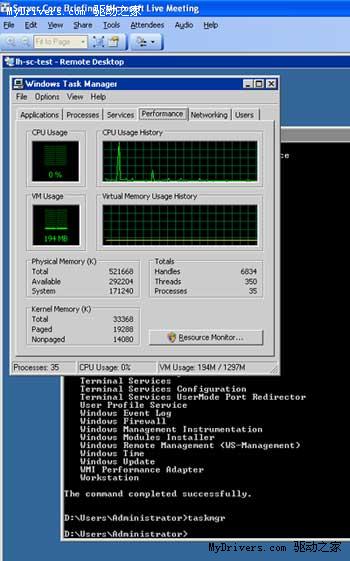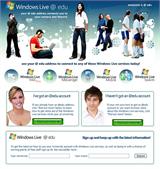Top Ten New Features of Windows Server 2008
For a server operating system, Windows Server 2008 (WS2K8) represents a leap forward in both its underlying architecture and surface-level functionality. Its ability to manage servers, the efficiency of hardware organization, the convenience of command-line remote hardware management, and the enhancement of the system security model will attract users of Windows 2000 and Windows Server 2003, changing how enterprises use Windows as well as the physical and logical architecture of networks.
Based on Microsoft's introduction at WinHEC 2007, here are the ten most anticipated features of WS2K8:
10. Self-healing NTFS File System
Since the DOS era, file system errors have meant that the corresponding volume must be taken offline for repair. In WS2K8, a new system service works quietly in the background, detecting file system errors and automatically repairing them without shutting down the server.
With this new service, when a file system error occurs, the server will only temporarily be unable to access some data, with overall operation remaining largely unaffected. As such, CHKDSK can essentially retire.
9. Parallel Session Creation
If you have a terminal server system or multiple users simultaneously logging into a home system, these are Sessions. Before WS2K8, Sessions were created one by one, which could be a bottleneck for large systems, such as when hundreds of people return to work on Monday mornings, and many had to wait for Session initialization.
Vista and WS2K8 introduce a new Session model that can initiate at least four Sessions simultaneously, and if the server has more than four processors, even more can be initiated simultaneously. For example, if you have a media center at home, family members can open media terminals in their respective rooms and receive video streams from the Vista server simultaneously without affecting speed.
8. Fast Shutdown Service
A historical problem with Windows has been slow shutdown processes. In Windows XP, once the shutdown begins, the system starts a 20-second countdown, then prompts the user whether manual program closure is needed. In Windows Server, this issue is even more pronounced.
In WS2K8, the 20-second countdown is replaced by a new service that continuously sends signals whenever an application needs to be closed. Developers initially questioned whether this new method might overly deprive applications of rights, but they have now accepted it as worthwhile.
7. Kernel Transaction Manager (KTM)
This feature is especially important for developers because it can significantly reduce or even eliminate the most common cause of system registry or file system crashes: multiple threads attempting to access the same resource.
There is also KTM in the Vista core, designed to facilitate extensive error recovery work almost transparently. KTM achieves this because it can function as a transaction manager that clients can connect to as part of a transaction.
6. SMB2 Network File System
Long ago, Windows introduced SMB as a network file system. However, SMB is now too old to meet current demands, so WS2K8 adopts SMB2 to better manage increasingly large media files.
In Microsoft's internal tests, the speed of an SMB2 media server can be four to five times faster than Windows Server 2003, equivalent to a 400% efficiency improvement.
5. Address Space Layout Randomization (ASLR)
ASLR already appeared in 64-bit Vista and ensures that any two concurrent instances of the operating system are loaded into different memory addresses each time.
Microsoft states that malware is essentially a collection of unruly code that does not execute according to the normal procedures required by the operating system. If it wants to write files on the user's disk, it must know where the system services are located. On 32-bit Windows XP SP2, if malware needs to call KERNEL32.DLL, that file is always loaded into the same memory space address, making it very easy to maliciously exploit.
However, with ASLR, the address space of each system service is random, making it nearly impossible for malware to easily find them.
4. Windows Hardware Error Architecture (WHEA)
Finally, Microsoft decided to standardize errors, specifically the protocol by which applications report discovered errors to the system.
A major issue with error reporting currently is the wide variety of ways devices report errors, with no standard between various hardware systems. This makes it difficult to aggregate all error resources and present them uniformly when writing applications, meaning a lot of specific code must be written for various specific situations.
In WS2K8, all hardware-related errors are reported to the system using the same interface, allowing third-party software to easily manage and eliminate errors, and making the development of management tools easier.
3. Virtualization
Although Microsoft streamlined its virtualization software "Viridian," it remains a boon for businesses, effectively reducing overall costs. While VMware stands out in the virtual machine field, Viridian allows Intel and AMD to provide support for hardware-based virtualization, offering a virtual hardware support platform, something difficult for VMware to achieve.
According to IDC, U.S. businesses have wasted hundreds of billions of dollars on processor resources they don't need, but this isn't their fault; it's due to the operating system's management issues, leading to up to 85% of CPU resources often being idle. A major goal of WS2K8 with virtualization is to enhance the utilization of idle resources and reduce waste.
2. PowerShell Command Line
PowerShell was originally planned as part of Vista but was only available as a free downloadable enhancement. It then became a key component of Exchange Server 2007 and will now be an indispensable member of WS2K8. This new command-line tool can complement graphical interface management or completely replace it.
Windows Server department director Iain McDonald declared, "If everything could be my decision, I would happily set PowerShell as the default shell for Windows. I love this thing."
At next month's TechEd 2007 conference, Microsoft will demonstrate some new applications of PowerShell.
1. Server Core
This is where Microsoft truly changes things. If you're a Unix and Linux administrator, you may be familiar with low-energy, virtualized, headless servers requiring just one terminal for management in protected environments, playing roles like DHCP and DNS servers. But now, Windows can do this too.
As a server operating system, one of the long-standing criticisms of Windows Server has been that it is "Windows" because administrators do not need to install graphic drivers, DirectX, ADO, OLE, etc., since they do not need to run user programs. Moreover, the graphical interface has always been a significant factor affecting Windows stability.
Starting with WS2K8, these components will become optional during installation. The current Beta 3 version can handle eight roles, and the final release will handle more, such as file server, domain controller, DHCP server, DNS server, etc., clearly positioned as secure, stable small specialized servers.
Additionally, if configured properly, administrators can remotely manage a Server Core installation without a graphical interface by simply enabling TCP port 3389.
PowerShell can also run on Server Core, but obviously, graphical interface programs cannot, .NET Framework will not be supported, and gaming is naturally out of the question.




